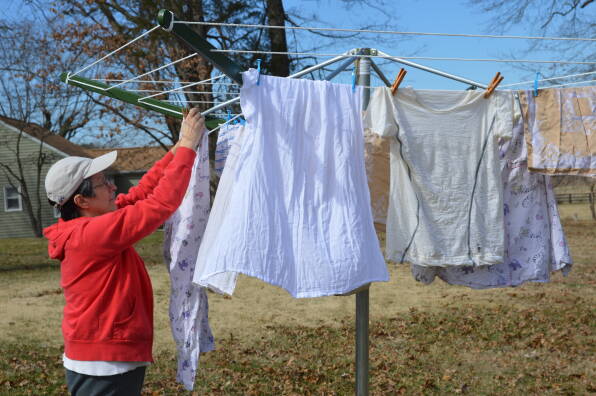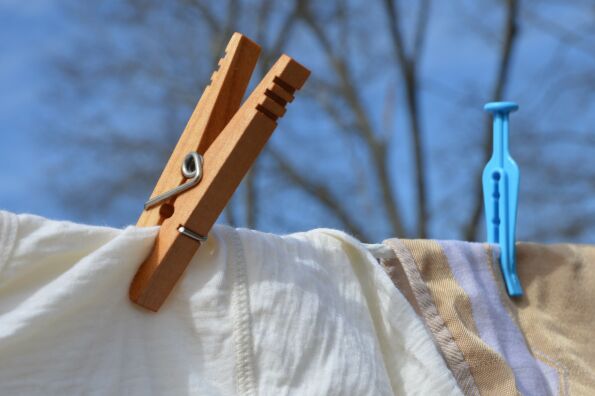Drying Laundry on an Umbrella Clothesline
Author: Ray Herndon
To make a difference in our overheated world, turn off the dryer and dry your laundry outdoors. Solar drying saves energy, lowers utility bills, lets clothes last longer, and brings us into closer harmony with nature.
I did not have quite the right sunny space for a long T-post type clothesline away from areas where birds roost, and didn't want to mow under a permanent clothesline anyways. And my single cord retractable clothesline couldn't hold a full load of laundry. My solution? The umbrella clothesline!
What's So Special About Umbrella Clotheslines?

#2. The average load of laundry requires about 35 feet of line, and weighs about 15-18 pounds. With it's 106 feet of line, their standard Umbrella Clothesline holds at least two loads of wet laundry, and the large model holds much more. The ropes of this umbrella clothesline will not sag down near the ground. And the topmost line of the standard model is easy enough to reach at 64 inches high.
#3. With a rotating umbrella clothesline you can stay in one place while hanging the laundry. You just spin the unit partly around anytime you need more hanging space. With a T-post style clothesline you have to walk down the length of a long clothesline, while carrying your laundry along the way.
#4. The braided rope is strong and does not rot or mold like cotton rope, nor stretch like nylon rope. Since it is woven, the clothes stay in place better than they do on vinyl-coated wire clotheslines.
Other Reasons For Using a Clothesline
Saves Energy and Money
Electric dryers use between 2 and 6 kw hours of electricity per load. My electric company charges 12.5 cents/kwh, so each dryer load costs 25 to 75 cents. At 6-8 loads per week, a clothesline can save hundreds of dollars per year on my electric bill. There are other costly inefficiencies of electric dryers as well. Running a dryer pumps air out of the house, and it is natural for outside air to come in to stabilize the air pressure. So your dryer sucks in hot outside air in the summer, and cold air in the winter. This makes the home less comfortable, and increases your utility bills. Over a few years, purchasing and maintaining a clothesline costs a fraction as much as a dryer!
Gentle on Clothes

No Fire Hazard
The lint in clothes dryers is a major cause of house fires every year in the US. And there is a potential for fire from any electrical device used in the home, especially those that run unattended.
Sunlight Disinfects and Freshens
Ultraviolet rays from the sun naturally disinfect clothing, makes white fabric whiter, and causes stains to fade. Clothes also smell fresher if dried in the sun. And since there is no static cling problem, perfumed dryer sheets are unnecessary. Tip: the sun may make dark clothing fade too, but turning them inside out helps to prevent this.
Helps the Environment
The energy used by dryers inevitably causes more carbon dioxide and other greenhouse gases to be released into the air. The US Energy Information Administration estimated that each kilowatt hour of electricity used in the US in 2020 resulted in 0.85 pounds of C02 emissions. That’s about 1.7 to 5.1 pounds of C02 per dryer load. My dryer running 6-8 loads per week would thus add up to around 530 to 2122 pounds of C02 per year.
Let's compare that to a car. The average US car gets 21 mpg and releases .90 pounds of C02 per mile. So each dryer load of laundry causes the same C02 emissions as driving 1.8 to 5.4 miles. My dryer running 6-8 loads per week would be equivalent to driving an extra 560 to 2246 miles per year. This might seem small, but considering that their are 89 million clothes dryers operating in the US it really adds up!
Be more aware of nature
Using an outdoor clothesline makes you more observant of weather, closer to nature, and more aware of the environment. Quietude and connection with nature have great benefits for mental health and spiritual grounding.
My last few recommendations
Location and Installation
Find a sunny spot for the clothesline that is not under trees or wires where birds might roost.
Also see my detailed article about
Hanging and Removing Laundry

Crunchy Towels
The primary cause of crunchy laundry is NOT air drying, it is detergent residue in the fabric. So first, use less detergent, as this article from a towel company describes. They also recommend adding vinegar or baking soda to the wash water to make your laundry softer. Even so, sometimes towels can still feel kind of hard or scratchy when they air dry. If you have a dryer, you can tumble them on low or zero heat for about 5 minutes to soften them. That is true for removing pollen as well, if that is a problem in your area.
Clothespins are important


